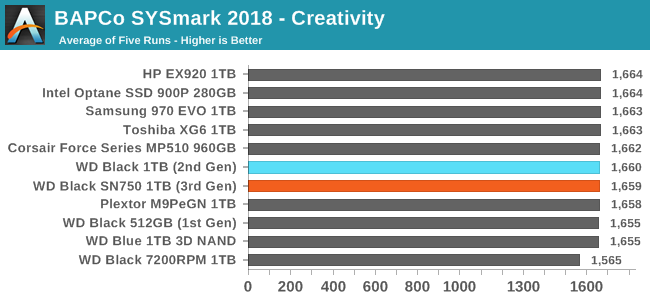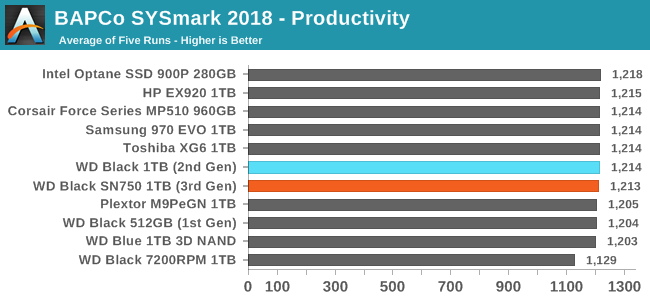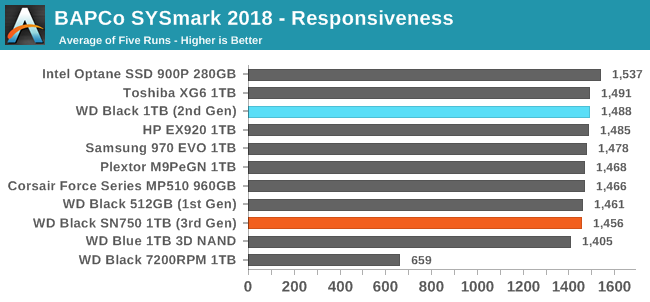The Western Digital WD Black SN750 SSD Review: Why Fix What Isn't Broken?
by Billy Tallis on January 18, 2019 8:01 AM ESTWhole-Drive Fill
This test starts with a freshly-erased drive and fills it with 128kB sequential writes at queue depth 32, recording the write speed for each 1GB segment. This test is not representative of any ordinary client/consumer usage pattern, but it does allow us to observe transitions in the drive's behavior as it fills up. This can allow us to estimate the size of any SLC write cache, and get a sense for how much performance remains on the rare occasions where real-world usage keeps writing data after filling the cache.
 |
|||||||||
The WD Black SN750's behavior during a full drive write is quite similar to that of its predecessor, albeit with a 5% improvement in write speed after the SLC cache fills up. The cache fills after about 12GB of writes, but since performance after the drop is steady at around 1.5GB/s the small cache isn't really a problem.
 |
|||||||||
| Average Throughput for last 16 GB | Overall Average Throughput | ||||||||
The WD Black SN750 offers best in class performance for long-duration sequential writes. After the SLC cache is full, the SN750 is about 5% faster than its predecessor for filling the rest of the drive. When looking at the total time to fill the drive, the SN750's advantage is slightly higher because its write speed to the SLC cache is also a bit faster.
BAPCo SYSmark 2018
BAPCo's SYSmark 2018 is an application-based benchmark that uses real-world applications to replay usage patterns of business users, with subscores for productivity, creativity and responsiveness. Scores represnt overall system performance and are calibrated against a reference system that is defined to score 1000 in each of the scenarios. A score of, say, 2000, would imply that the system under test is twice as fast as the reference system.
SYSmark scores are based on total application response time as seen by the user, including not only storage latency but time spent by the processor. This means there's a limit to how much a storage improvement could possibly increase scores, because the SSD is only in use for a small fraction of the total test duration. This is a significant difference from our ATSB tests where only the storage portion of the workload is replicated and disk idle times are cut short to a maximum of 25ms.
| AnandTech SYSmark SSD Testbed | |
| CPU | Intel Core i5-7400 |
| Motherboard | ASUS PRIME Z270-A |
| Chipset | Intel Z270 |
| Memory | 2x 8GB Corsair Vengeance DDR4-2400 CL17 |
| Case | In Win C583 |
| Power Supply | Cooler Master G550M |
| OS | Windows 10 64-bit, version 1803 |
Our SSD testing with SYSmark uses a different test system than the rest of our SSD tests. This machine is set up to measure total system power consumption rather than just the drive's power.



The new WD Black SN750 regresses slightly in performance on SYSmark 2018, primarily on the responsiveness test, which is the subscore that's most sensitive to storage performance. The SN750 still clearly outperforms the WD Blue SATA SSD but even managed to fall behind the first-generation WD Black that used planar TLC and a third-party controller.
Energy Usage
The SYSmark energy usage scores measure total system power consumption, excluding the display. Our SYSmark test system idles at around 26 W and peaks at over 60 W measured at the wall during the benchmark run. SATA SSDs seldom exceed 5 W and idle at a fraction of a watt, and the SSDs spend most of the test idle. This means the energy usage scores will inevitably be very close. A typical notebook system will tend to be better optimized for power efficiency than this desktop system, so the SSD would account for a much larger portion of the total and the score difference between SSDs would be more noticeable.

The WD Black SN750 turns in an excellent energy consumption score, lower than any drive in this bunch save for the WD Blue SATA SSD.










54 Comments
View All Comments
Oxford Guy - Monday, January 21, 2019 - link
It's weird to review minor products and not review something major like the GTX 960.It may be explainable without conspiracy but it's still weird, in terms of priorities.
Alistair - Friday, January 18, 2019 - link
Can't wait to read the SX8200 Pro review. I've bought a few, and I believe they are the best performing drives for the money right now. Excellent. I stopped buying Samsung after they started denying warranties in Canada (and they don't seem to want to fix that). Anyways the Samsung drives cost almost twice the SX8200 pro and perform exactly the same pretty much. Maybe the SX8200 Pro is even faster than the 970 EVO honestly.gglaw - Friday, January 18, 2019 - link
A few from decent reviewers are already up for this and the HP EX950 which are small upgrades over the incredibly well-rounded drives they replaced. The SX8200 (non-pro) and EX920 go on so many massive sales it is hard to beat them until the newer drives start dropping in price. The average home user would never know whether they had a 970 Pro, SX8200, SX8200 Pro, or EX950 running so major price differences would make the decision for me. After my initial experiences with the SX8200/EX920, these have been all I've stocked for close to a year. Made me almost regret my 970 Pro. They regularly go on sale for ~$75 for 500GB, and $135 for 1TB versions so my SSD adventures have become rather boring with no close 2nd place I would even consider buying.I'm likely going to get a SX8200 Pro just because I can't help myself with new versions of my favorite drives, but I'm already 99% positive I'll be in the same boat of not being able to tell any difference with the small upgrade. Then I'll have buyer's remorse again like the 970 Pro, knowing the 1TB version of the cheaper drive is barely more than the new 500GB one (SX8200 1TB $135, Pro 500GB $115).
ajp_anton - Friday, January 18, 2019 - link
What's wrong with WD's idle power consumption, and am I right assuming that that makes it unsuitable for laptops (mobile ones, not gaming)?Billy Tallis - Friday, January 18, 2019 - link
We test SSDs on a desktop, and that means we need to jump through some hoops to get PCIe power management enabled. I've never encountered a desktop motherboard that even has PCIe ASPM enabled by default, and when you are lucky enough to get a BIOS option to turn it on, you can't trust that to take care of everything. Even with the OS set to override the motherboard's settings, not all drives are able to enter their deepest sleep state on our testbed.I view this situation as being similar to DEVSLEEP for SATA drives. It's pretty likely that a laptop which was designed to use M.2 PCIe storage will have all the right firmware bits enabled to use the deepest power saving modes, but they're normally not used (or usable) on a desktop and I don't currently have equipment that can work around that.
hnlog - Saturday, January 19, 2019 - link
WD Black NVMe has problem on Linux with default parameter.Is it fixed on the new model?
https://community.wd.com/t/linux-support-for-wd-bl...
I think WD should test before shipping the former model.
Billy Tallis - Monday, January 21, 2019 - link
Basically every NVMe SSD vendor has shipped something that turned out to have serious power management bugs, most often with APST and only on certain host systems. It's pretty clear that no vendors (SSD or motherboard) are thoroughly testing those features before shipping, and instead just make sure that it works with a small handful of Windows configurations. But even the Windows NVMe driver is a moving target and new builds have caused problems.It would probably help if the UNH-IOL NVMe Integrator's List testing included APST, but their current test plan only checks whether the drive can handle manually setting power states. And even if they were more thorough, only a few vendors put consumer drives through that certification.
FXi - Sunday, January 20, 2019 - link
I wonder when we'll see the upper end of sizes in consumer drives jump to 4TB. Durability seems to be ready. Perhaps consumer need isn't quite there. But if controllers can handle it and layers exist for it to be built to that size in the M2 format, you'd think that's where they would go next since prices have come out of the stratosphere.eastcoast_pete - Sunday, January 20, 2019 - link
Is it just me, or do these comparisons make the HP 920 look quite good? Not in terms of top performance, but in performance/price. Has anybody here had any experiences with 920 drives?piasabird - Sunday, January 20, 2019 - link
Why not compare similar products together? Why is one drive a 2 TB drive? Since 2TB has more save locations it may naturally be faster due to drive space, cache size, energy usage, etc. Maybe Anandtech doesnt use samsung drives because Samsung will not donate the drives for free but other companies would give them free gear to test.